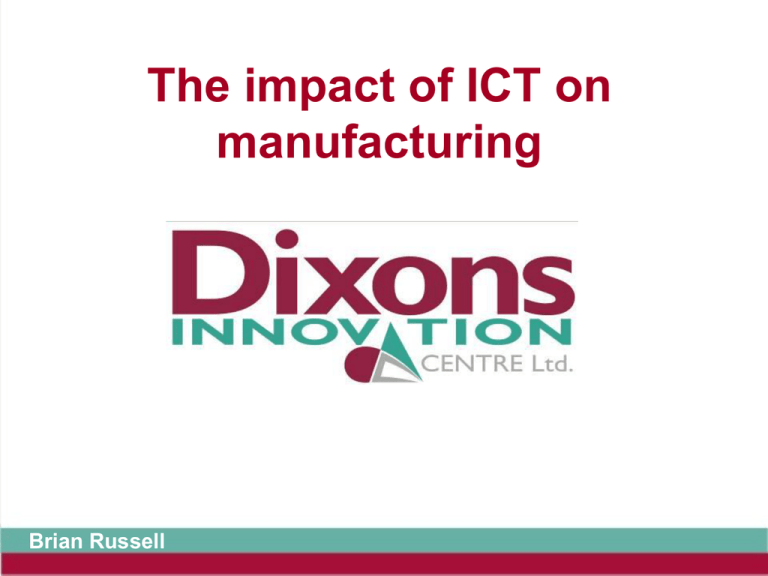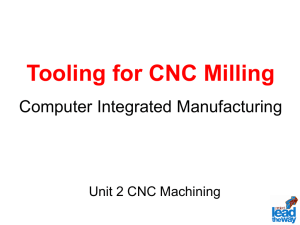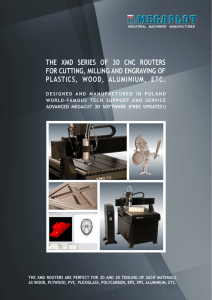The impact of ICT on manufacturing
advertisement

The impact of ICT on manufacturing Brian Russell Exam expectations You are expected to know about how ICT is used to aid manufacturing both in school and in industry so always expect questions in exam to relate to this topic CAD/CAM - benefits • • • • • • Repeatability Easier data storage and retrieval Quick changes/set-ups Reduce labour costs Flexibility Full automation capability CAD/CAM - drawbacks • Security of data • Risk of data corruption • Initial investment – plant and training • Don’t refer to job losses Computer Aided Manufacture • • • • • • • • Printers Knife cutters Milling/engraving machines Routers Lathes Laser-cutters Embroidery machines Rapid prototyping Digital printers • • • • • • Used for one-offs/prototypes Small print runs Direct onto fabrics/carpets Large areas Transfer printing Sublimation printing Vinyl cutters • • • • • • • Signs (especially vehicles) Graphics on prototypes Iron-on vinyl (T shirts) Masks for stencilling/sandblasting Labels for prototypes Card nets for prototypes Decoration on ceramics Knife cutting and creasing • Used for small scale production of cartons • Samples and small batch production Milling/engraving machines • • • • Cutting flat (2D) shapes in rigid materials Engraving copper board for electronics Signage name plaques etc. Raised forms (3D) Routers • • • • Used mainly on timber (MDF) and rigid foams 3 axis – partial 3D 4 axis – turns material to get full 3D 5 axis – full 3D, much better detail Lathes • • • • Work revolves against cutter Cylindrical Conical Spherical Laser cutters • Very accurate cutting for sheet materials • Engraving • Small scale machines found in schools Plasma cutting • Used for cutting sheet metal • Not found in schools Water jet cutting • Fine cutting of metal sheet • Again, not found in schools Embroidery Machines Detailed designs on fabric • Text & graphics • Repeat patterns Rapid Prototyping Prototype built up layer by layer – Stereo lithography • 3D printing • 3D layering Impact of ICT on manufacturing Further than CAD/CAM • Electronic Data Interchange (EDI) • Electronic Product Definition (EPD) • Product Data Management (PDM) Electronic Data Interchange Electronic Product Definition • Product and process data stored electronically on one database • Total Product Modelling (TPM) • Virtual Product Development (VPD) • Virtual Manufacturing Electronic Product Definition Release mechanisms: • Who sees information? • When is it available? • What form is the information in? Product Data Management Gerber Garment Technology Inc. • Up to date information for both manufacturers and retailers • Instant changes to all concerned parties • World wide potential • Quality monitoring via remote cameras Product Data Management Allows manufacturers to: • Start with an illustration and build product information around it • Customise specification sheets to suit their manufacturing needs • Use digital camera to show construction details • Manage concurrent design, development, merchandising and production Product Data Management Allows manufacturers to: • Communicate manufacturing data next door or world wide • Record and monitor all costs • Monitor quality assurance • Reduce product time-to-market • Successfully use quick response manufacturing techniques Product Data Management Allows manufacturers to: • Respond to five or more new “seasons” in a year • Right product at the right time Remote manufacturing • Very common especially in the printing industry • Maximises savings by manufacturing abroad Video conferencing Advantages include: • Time saved travelling • Costs • Face to face • Observe facial/body language • Several locations can be linked together Disadvantages include: • Time differences Just in Time • Shared information systems • Reduced lead times • Less finance tied up in stock Automation • Numerous interlinked sub-systems centrally controlled • Use of robots for repetitive/dangerous tasks • Monitoring/measuring • Logistics Flexible Manufacturing • Benefits of one-off production at mass production prices • Only possible with ICT Computerised measuring • Very complex measuring tasks can be undertaken at various stages of manufacturing Compression testing • Ensuring the structures can withstand pushing forces Tensile testing • Ensuring structures can withstand pulling forces Simulated destruction testing • Software can simulate how structures will perform under impact loads • This is a cheaper option than destructive testing Product testing • Extensive testing can be undertaken in controlled conditions Stress analysis • Components can be tested at many stages of the design and manufacturing stages Simulated fatigue testing • Saves time and costs as components can be tested before manufacture • Uses finite element analysis software Accelerated wear testing • Wear testing can be performed with materials and finished products Logistics • As well as design and manufacturing applications the whole supply chain needs to be carefully planned and managed Supply chain management • Ensuring that materials are at the point of processing, products and components are made on schedule and delivered to the customer on time is essential for efficient manufacturing ICT makes a major contribution to this











